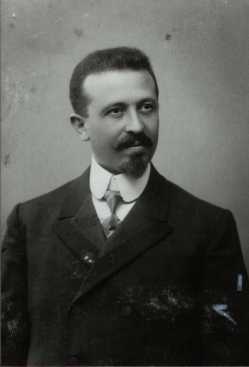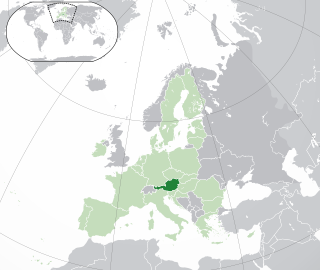
Hohenems is a town in the Austrian state of Vorarlberg in the Dornbirn district. It lies in the middle of the Austrian part of the Rhine valley. With a population of 16,946, it is the fifth largest municipality in Vorarlberg and currently has the fastest population growth in the state. Hohenems' attractions include a Renaissance palace dating back to the 16th century, a Jewish history museum, and the old town center.

Aaron Tänzer was a rabbi in Austria and Germany, chaplain and author.

The history of the Jews in Austria begun after the exodus of Jews from Judea under Roman occupation. There have been Jews in Austria since the 3rd century CE. Over the course of many centuries, the political status of the community rose and fell many times: during certain periods, the Jewish community prospered and enjoyed political equality, and during other periods it suffered pogroms, deportations to concentration camps and mass murder, and antisemitism. The Holocaust drastically reduced the Jewish community in Austria and only 8,140 Jews remained in Austria according to the 2001 census. Today, Austria has a Jewish population of 10,300 and a total of 33,000 when including any Austrian with at least one Jewish grandparent.
The history of the Jews in Salzburg, Austria goes back several millennia. Despite being a non-secular province with a Catholic Archbishop as the head of the state, Salzburg has a long record of Jewish history.

The history of the Jews in Indonesia began with the arrival of early European explorers and settlers, and the first Jews arrived in the 17th century. Most Indonesian Jews arrived from Southern Europe, the United Kingdom, the Netherlands, Belgium, Germany, France, the Middle East, North Africa, India, China, and Latin America. Jews in Indonesia presently form a very small Jewish community of about 500–1,000, from a nadir of about 20 in 1997. Judaism is not recognized as one of the country's six major religions, however its practices are allowed under Perpres 1965 No. 1 and article 29 paragraph 2 of the Constitution of Indonesia. Therefore, members of the local Jewish community have to choose to register as "Belief in One Almighty God" or another recognized religions on their official identity cards.

The history of the Jews in Luxembourg dates back to the 1200s. There are roughly 1,200 Jews in Luxembourg, and Jews form one of the largest and most important religious and ethnic minority communities in Luxembourg historically.

The history of the Jews in Slovenia and areas connected with it goes back to the times of Ancient Rome. In 2011, the small Slovenian Jewish community was estimated at 500 to 1,000 members, of whom around 130 are officially registered, most of whom live in the capital, Ljubljana.

The history of the Jews in Ústí nad Labem in the Czech Republic dates back to 1848, following the emancipation of Austrian Jews. The greatest expansion achieved owing to presence of two significant families, who contributed to city development, at the end of 19th and at the beginning of 20th century. Two following dictatorships had devastating effect on the community. Most Jews fled prior to or during World War II. In November 1938, after the Munich Agreement, the few Jews that remained in Ústí were sent to extermination camps.

The Old Jewish Cemetery of Kraków, more commonly known as the Remah Cemetery, is a historic necropolis established in the years 1535–1551, and one of the oldest existing Jewish cemeteries in Poland. It is situated at 40 Szeroka Street in the Kazimierz district of Kraków, beside the 16th-century Remah Synagogue. The cemetery bears the name of Rabbi Moses Isserles, whose name is abbreviated as Remah.
The history of the Jews in Munich, Germany, dates back to the beginning of the 13th century. An early written reference to a Jewish presence in Munich is dated 1229, when Abraham de Munichen acted as a witness to the sale of a house in Ratisbon.
The history of the Jews in Vienna, Austria, goes back over eight hundred years. There is evidence of a Jewish presence in Vienna from the 12th century onwards.

Jews lived in the northern Hungarian town of Verpelét and the surrounding Heves county from the 15th century or earlier up to the late 17th century, after which they were excluded from the area. During the 19th century the Jewish population increased in the area, with 174 living in the town itself in 1880. Hungary's only wooden synagogue was in Verpelét. Jewish students also travelled in to study at the yeshiva established there in the early 20th century, which was closed down by the government in 1942. In 1944 under the German occupation the Jews of the area were sent for forced labour or killed at Auschwitz; only eleven returned to the town, and the synagogue has been converted for other use.

The Spandau Synagogue was a former Orthodox Jewish congregation and synagogue, located at 12 Lindenufer, in the Old Town area of Spandau, Berlin, Germany.

The history of the Jews in Łuków, Poland spans from the 15th to 20th century. The community flourished from the 18th-early 20th century, following the confirmation of certain privileges granted to Polish Jews in 1659. The community had its own Synagogues, Yeshivas, beit midrash, mikveh, schools, and community center. By the 19th century, the majority of the general population of Łuków was Jewish, with many people working in a shoe factory. Members of the community followed various movements, including Hasidic Judaism, socialism, labor movements, and Zionism. The majority of the Jewish community of Łuków was murdered in the Holocaust. There were only about 150 survivors in total, most of whom had left for the Soviet Union.
The history of the Jews in Kyiv stretches from the 10th century CE to the 21st century, and forms part of the history of the Jews in Ukraine.

The Jewish community of Oldenburg in northwest Germany was established as early as the 14th century. It has existed consecutively ever since, except for occasional deportations by the local rulers of the Duchy of Oldenburg and under the Holocaust, which annihilated the majority of Jews left in the city. Nevertheless, after the Holocaust, Jewish survivors returned and resettled in Oldenburg, in a community that now operates actively within the Central Council of Jews in Germany.

The first record of the Jewish community in Bratislava, capital of Slovakia, dates from 1251. Until the end of World War I, Bratislava was a multicultural city with a Hungarian and German majority and a Slovak and Jewish minority. In 1806 when the city was part of the Kingdom of Hungary, Rabbi Moses Sofer established the Pressburg Yeshiva and the city emerged as the center of Central European Jewry and a leading power in the opposition to the Reform movement in Judaism in Europe. Pressburg Yeshiva produced hundreds of future leaders of Austro-Hungarian Jewry who made major influence on the general traditional orthodox and future Charedi Judaism.

The Jewish Museum Hohenems is a regional museum in Hohenems in the Austrian state of Vorarlberg. The museum deals with the Jewish presence in Hohenems as well as surrounding regions. It also covers the Diaspora and Israel and puts the future of the European immigration society into focus.

The Pogrom Monument is located on Eduard-Wallnöfer-Platz, in the centre of Innsbruck, and commemorates the November pogroms of 1938, during which the Innsbruck citizens Josef Adler, Wilhelm Bauer, Richard Berger and Richard Graubart were murdered. The memorial was erected in 1997.
Ilse Brüll (1925–1942) was an Austrian-Jewish girl killed at Auschwitz who became a symbol in Austria for young girls murdered by Nazis in the Holocaust.
















